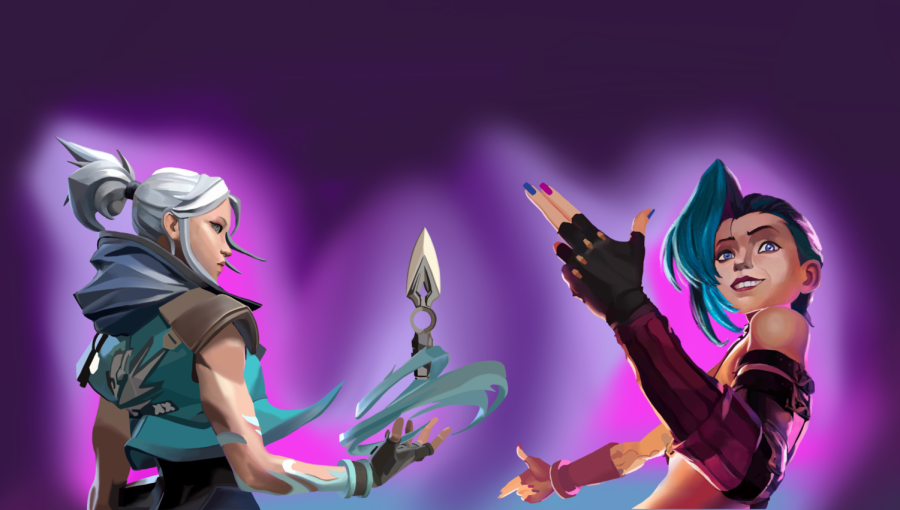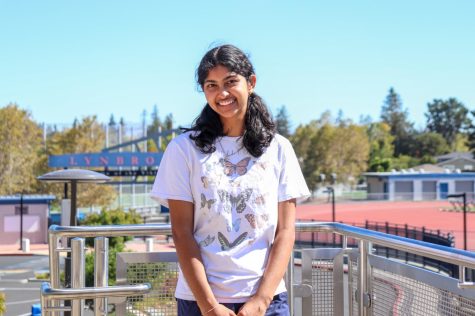Gaming culture: The latest updates are taking over
Graphic illustration by Anwen Huang
Characters Jett and Jinx, from the games Valorant and League of Legends, respectively, are part of video games that have recently skyrocketed in popularity.
March 8, 2022
Gaming culture has seeped into the daily lives of many students, with teenagers constantly making references to games and flocking to chatting platforms for gamers such as Discord. Even celebrities like Snoop Dogg and politicians like Alexandria Ocasio-Cortez have appeared on the popular gaming platform Twitch. While formerly a niche activity, gaming has been destigmatized and is reaching the forefront of popular culture.
Video gaming has skyrocketed in popularity. In 2020, the gaming industry brought in $155 billion in revenue, and in 2025, it’s expected to hit $260 billion, a 67% increase. These statistics contrast the industry’s modest $63 billion revenue in 2012 and can be attributed to a rising interest in online gaming.
The former lack of representation in gaming stemmed from stereotypes about gamers and a stigma against devoting time to playing games. When consoles first became available in the 1970s, the people who participated were predominantly those interested in the future of technology. These individuals were often regarded as nerds and introverts, and, with women being historically excluded from the frontiers of science, were predominantly male.
“The demographics of gaming diversified a lot during COVID-19 with people staying at home without their regular activities,” said Gurshaan Arora, social media coordinator for the New York Subliners, a professional Call of Duty league. “As gaming becomes more mainstream, it’s hard not to be exposed to it.”
Previously, the consoles and computers needed for gaming were expensive, in addition to the price of games themselves, which usually cost additional money. Recently, however, the availability of downloadable games on devices people already own, such as smartphones, Macs and PCs, have made games more accessible to the average population.
During the COVID-19 pandemic, many people turned to gaming as a means of entertainment and an accessible option of connecting with others.
“There are a lot of new games that are free or inexpensive that more people can play,” sophomore Anna Wang said. “It’s becoming more accessible. There’s mobile gaming, PC, everything.”
Following demographic changes, developers have also been creating more games that appeal to casual gamers. Some popular games among students include combat games Valorant, Call of Duty and Halo and role-playing games League of Legends and Genshin Impact. Widely acknowledged as a classic video game, Minecraft also remains popular. Each game has its own unique community, and oftentimes, people play games with existing friends while making new ones.
“I definitely met more people through gaming,” Wang said. “In this area, everyone’s really focused on school. Making friends online gives me a perspective as to how other people view their life.”
Streaming gameplay online has also become more widespread. Launched in 2011, Twitch is a popular streaming platform that was once primarily used by devoted gamers, but it has since become a hub for a much larger audience. It has also taken strides in leveling gender inequality in the gaming community, boasting a sizable number of female streamers.
“Twitch is a platform that actively listens to female streamers,” said Ramya Kumaradhev, software development manager at Twitch. “When there is a complaint on the platform, Twitch tends to take action immediately.”
Viewers enjoy Twitch because of its unedited and real-time content, which — along with a variety of communication options such as live chat, subscription gifts and emotes — helps viewers feel closer to their favorite streamers.
“Twitch has a community like Reddit,” Kumaradhev said. “I think the way it differs from YouTube and any other spaces is that they focus primarily on monetization, but Twitch focuses on building that community. There’s a lot of loyal streamers and viewers here, and that space has continued to stay preserved.”
Public figures who don’t have backgrounds in gaming have also joined the platform. During their 2020 election campaign, Ocasio-Cortez and politician Ilhan Omar streamed the game Among Us on Twitch to target a younger audience of voters. On YouTube, previously non-gaming creators such as Bretman Rock and Corpse Husband have joined content creation groups with gaming creators like Sykkuno and Pokimane. This mixture of genres has brought new audiences into gaming and created close-knit subgroups.
“If you want to relate to your audience, you have to try to envelop yourself into what they find interesting,” Arora said. “I think on a local level, gaming is something that appeals to a lot of people just because it’s so widespread.”
Due to the newfound presence of inclusivity, viewers along with streamers have increased not only in numbers but also in diversity, both on Twitch and in-game. With expanding demographics and increased accessibility, gaming culture has become prevalent in daily life and is expected to keep growing in the future.
“Gaming isn’t something that should be limited by opinion,” Arora said. “There’s no reason for the stigma around it. Just the fact that there’s different ways to experience it means everyone can take part in it.”






























































